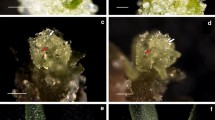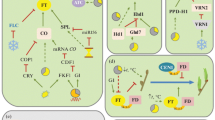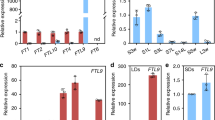Abstract
FLOWERING LOCUS T (FT) like genes are crucial regulators (both positive and negative) of flowering in angiosperms. We identified two FT homologs in Chenopodium rubrum, a short-day species used as a model plant for the studies of photoperiodic flower induction. We found that CrFTL1 gene was highly inducible by a 12-h dark period, which in turn induced flowering. On the other hand, photoperiodic treatments that did not induce flowering (short dark periods, or a permissive darkness interrupted by a night break) caused only a slight increase in CrFTL1 mRNA level. We demonstrated diurnal oscillation of CrFTL1 expression with peaks in the middle of a light period. The oscillation persisted under constant darkness. Unlike FT homologs in rice and Pharbitis, the CrFTL1 expression under constant darkness was very low. The CrFTL2 gene showed constitutive expression. We suggest that the CrFTL1 gene may play a role as a floral regulator, but the function of CrFTL2 remains unknown.









Similar content being viewed by others
Abbreviations
- AP1:
-
APETALA1
- ATC:
-
Arabidopsis thaliana CENTRORADIALIS homolog
- BFT:
-
BROTHER OF FT AND TFL1
- CEN:
-
CENTRORADIALIS
- CrFL:
-
FLORICAULA/LEAFY
- FT:
-
FLOWERING LOCUS T
- FTL:
-
FLOWERING LOCUS T- like
- Hd1:
-
Heading date 1
- Hd3a:
-
Heading date 3a
- MFT:
-
MOTHER OF FT AND TFL1
- SP:
-
SELF PRUNING
- TFL:
-
TERMINAL FLOWER
- TSF:
-
TWIN SISTER OF FT
References
Ahn JH, Miller D, Winter VJ, Banfield MJ, Lee JH, Yoo SY, Henz SR, Brady RL, Weigel D (2006) A divergent external loop confers antagonistic activity on floral regulators FT and TFL1. EMBO J 25:605–614
Blažková A, Vondráková Z, Krekule J (2000) The shoot apex as a marker of the responsivity to photoperiodic treatment inducing flowering of Chenopodium rubrum L. Biol Plant 43:31–34
Blazquez MA, Ahn JH, Weigel D (2003) A thermosensory pathway controlling flowering time in Arabidopsis thaliana. Nat Genet 33:168–171
Bradley D, Ratcliffe O, Vincent C, Carpenter R, Coen C (1997) Inflorescence commitment and architecture in Arabidopsis. Science 275:80–83
Carmel-Goren L, Liu YS, Lifschitz E, Zamir D (2003) The SELF-PRUNING gene family in tomato. Plant Mol Biol 52:1215–1222
Cumming BG (1967) Early-flowering plants. In: Wilt FH, Wessels NK (eds) Methods in developmental biology. Crowell, New York, pp 277–299
Cumming BG, Seabrook JEA (1985) Chenopodium. In: Halevy AH (ed) CRC handbook of flowering, vol II. CRC Press, Boca Raton, pp 96–228
Cumming BG, Hendricks SB, Borthwick HA (1965) Rhythmic flowering responses and phytochrome changes in a selection of Chenopodium rubrum. Can J Bot 43:825–853
Doi K, Izawa T, Fuse T, Yamaguchi U, Kubo T, Shimatani Z, Yano M, Yoshimura A (2004) Ehd1, a B-type response regulator in rice, confers short-day promotion of flowering and controls FT like gene expression independently of Hd1. Gene Dev 18:926–936
Felsenstein J (2004) Inferring phylogenies. Sinauer Associates, Inc, Sunderland Mass
Hayama R, Yokoi S, Tamaki S, Yano M, Shimamoto K (2003) Adaptation of photoperiodic control pathways produces short-day flowering in rice. Nature 422:719–722
Hayama R, Agashe B, Luley E, King R, Coupland G (2007) A circadian rhythm set by dusk determines the expression of FT homologs and the short-day photoperiodic flowering response in Pharbitis. Plant Cell 19:2988–3000
Hecht V, Foucher F, Ferrandiz C, Macknight R, Navarro C, Morin J, Vardy ME, Ellis N, Beltran JP, Rameau C, Weller JL (2005) Conservation of Arabidopsis flowering genes in model legumes. Plant Physiol 137:1420–1434
Hsu CY, Liu YX, Luthe DS, Yuceer C (2006) Poplar FT2 shortens the juvenile phase and promotes seasonal flowering. Plant Cell 18:1846–1861
Huang JC, Chen F (2006) Simultaneous amplification of 5′ and 3′ cDNA ends based on template-switching effect and inverse PCR. BioTechniques 40:187–189
Ishikawa R, Tamaki S, Yokoi S, Inagaki N, Shinomura T, Takano M, Shimamoto K (2005) Suppression of the floral activator Hd3a is the principal cause of the night break effect in rice. Plant Cell 17:3326–3336
Jaeger KE, Wigge PA (2007) FT protein acts as a long-range signal in Arabidopsis. Curr Biol 17:1050–1054
Kardailsky I, Shukla V, Ahn JH, Dagenais N, Christensen SK, Nguyen JT, Chory J, Harrison MJ, Weigel D (1999) Activation tagging of the floral inducer FT. Science 286:1962–1965
King RW (1972) Timing in Chenopodium rubrum of export of the floral stimulus from the cotyledons and its action at the shoot apex. Can J Bot 50:697–702
Kobayashi Y, Kaya H, Goto K, Iwabuchi M, Araki T (1999) A pair of related genes with antagonistic roles in mediating flowering signals. Science 286:1960–1962
Kojima S, Takahashi Y, Kobayashi Y, Monna L, Sasaki T, Araki T, Yano M (2002) Hd3a, a rice ortholog of the Arabidopsis FT gene, promotes transition to flowering downstream of Hd1 under short day conditions. Plant Cell Physiol 43:1096–1105
Lee JH, Hong SM, Yoo SJ, Park OK, Lee JS, Ahn JH (2006) Integration of floral inductive signals by flowering locus T and supressor of overexpression of Constans 1. Physiol Plantarum 126:475–483
Lynch M, Force A (2000) The probability of duplicate gene preservation by subfunctionalization. Genetics 154:459–473
Mimida N, Goto K, Kobayashi Y, Araki T, Ahn JH, Weigel D, Murata M, Motoyoshi F, Sakamoto W (2001) Functional divergence of the TFL1-like gene family in Arabidopsis revealed by characterization of a novel homologue. Genes Cells 6:327–336
Ohno S (1970) Evolution by gene duplication. Springer-Verlag, Berlin
Otto SP, Yong P (2002) The evolution of gene duplicates. Adv Genet 46:451–483
Partap T, Joshi BD, Galway NW (1998) Chenopods. Chenopodium spp. Promoting the conservation and use of underutilized and neglected crops, vol 22. Institute of Plant Genetics and Crop Plant Research, Gatersleben/International Plant Genetic Resources Institute, Rome
Putterill J, Robson F, Lee K, Simon R, Coupland G (1995) The CONSTANS gene of Arabidopsis promotes flowering and encodes a protein showing similarities to zinc finger transcription factors. Cell 80:847–857
Rahiminejad MR, Gornall RJ (2004) Flavonoid evidence for allopolyploidy in the Chenopodium album aggregate (Amaranthaceae). Plant Syst Evol 246:77–87
Samach A, Onouchi H, Gold SE, Ditta GS, Schwarz-Sommer Z, Yanofsky MF, Coupland G (2000) Distinct roles of CONSTANS target genes in reproductive development of Arabidopsis. Science 288:1613–1616
Schoentgen F, Saccoccio F, Jolles J, Bernier I, Jolles P (1987) Complete amino-acid-sequence of a basic 21 kDa protein from bovine brain cytosol. Euro J Biochem 166:333–338
Seidlová F, Krekule J (1973) The negative response of photoperiodic floral induction in Chenopodium rubrum L. to preceding growth. Ann Bot 37:605–614
Štorchová H, Hrdličková R, Chrtek J Jr, Tetera M, Fitze D, Fehrer J (2000) An improved method of DNA isolation from plants collected in the field and conserved in saturated NaCl/CTAB solution. Taxon 49:79–84
Suarez-Lopez P, Wheatley K, Robson F, Onouchi H, Valverde F, Coupland G (2001) CONSTANS mediates between the circadian clock and the control of flowering in Arabidopsis. Nature 410:1116–1120
Swofford DL (2003) PAUP*. Phylogenetic analysis using parsimony (*and other methods). Version 4. Sinauer Associates, Sunderland
Tamaki S, Matsuo S, Wong HL, Yokoi S, Shimamoto K (2007) Hd3a protein is a mobile flowering signal in rice. Science 316:1033–1036
Ullmann J, Seidlová F, Krekule J, Pavlová L (1985) Chenopodium rubrum as a model plant for testing the flowering effects of PGRs. Biol Plant 27:367–372
Veit J, Wagner E, Albrechtová JTP (2004) Isolation of a FLORICAULA/LEAFY putative orthologue from Chenopodium rubrum and its expression during photoperiodic flower induction. Plant Physiol Biochem 42:573–578
Wada M, Cao Q, Nobuhiro K, Soejima J, Masuda T (2002) Apple has two orthologs of FLORICAULA/LEAFY involved in flowering. Plant Mol Biol 49:567–577
Wigge PA, Kim MC, Jaeger KE, Busch W, Schmid M, Lohman JU, Weigel D (2005) Integration of spatial and temporal information during floral induction in Arabidopsis. Science 309:1056–1059
Yamaguchi A, Kobayashi Y, Goto K, Abe M, Araki T (2005) TWIN SISTER OF FT (TSF) acts as a floral pathway integrator redundantly with FT. Plant Cell Physiol 46:1175–1189
Yano M, Katayose Y, Ashikari M, Yamanouchi U, Monna L, Fuse T, Baba T, Yamamoto K, Umehara Y, Nagamura Y, Sasaki T (2000) Hd1, a major photoperiod sensitivity quantitative trait locus in rice, is closely related to the Arabidopsis flowering time gene CONSTANS. Plant Cell 12:2473–2484
Yoo SY, Kardailsky I, Lee JS, Weigel D, Ahn JH (2004) Acceleration of flowering by overexpression of MFT (MOTHER OF FT AND TFL1). Mol Cells 17:95–101
Zeevaart JAD (1976) Physiology of flower formation. Annu Rev Plant Physiol Plant Mol Biol 27:321–348
Acknowledgments
We appreciate stimulating discussion and helpful comments by Frideta Seidlová and Ivana Macháčková of the Institute of Experimental Botany, Prague; Gary J. Houliston of the University of Alaska, Fairbanks, USA; Edgar Wagner of the University of Freiburg, Germany; and two anonymous reviewers. We are thankful to Justyna Veit for designing some primer sequences and helping with qRT PCR optimization. The excellent technical assistance of Martina Dostálová was highly appreciated. Financial support was provided through the grants GACR 522/05/0300 to H.S. and Z-5038910 to IEB AS CR, v.v.i, Prague.
Author information
Authors and Affiliations
Corresponding author
Rights and permissions
About this article
Cite this article
Cháb, D., Kolář, J., Olson, M.S. et al. Two FLOWERING LOCUS T (FT) homologs in Chenopodium rubrum differ in expression patterns. Planta 228, 929–940 (2008). https://doi.org/10.1007/s00425-008-0792-3
Received:
Accepted:
Published:
Issue Date:
DOI: https://doi.org/10.1007/s00425-008-0792-3




